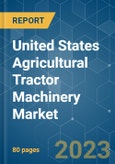Key Highlights
- Agriculture is a major occupation in the United States, where mechanization of farming is considered an important reason for increased productivity, sales, and export. Also, the shorter replacement cycles of 9 years in advanced economies, like the United States, increase the demand for new tractors and drive the market.
- In addition, the farmers in the country have been able to avail themselves of timely subsidies on the purchases of agricultural tractors. This, in turn, has helped even small-scale farmers to invest in agricultural equipment, like tractors, in the country.
- According to data from the Quarterly Census of Employment and Wages (QCEW), wage and salary employment in agriculture (measured as the annual average number of full- and part-time jobs) - including support industries such as farm labor contracting - stabilized in the 2000s and has been on a gradual upward trend since 2010, rising from 1.07 million in 2010 to 1.16 million in 2020, a gain of 9 percent. Thus, the growing wages of farm labor are further propelling the farmers toward adopting agricultural equipment, like tractors, and boosting the market's growth.
- Some of the players in the country are involved in research and development and the launch of advanced tractors in the market. For instance, in 2021, players concentrated on producing fully electric and driver-optional tractors in the country. These tractors are being funded through the United States Department of Agriculture's (USDA) Conservation Innovation Grant program to automate specific blueberry field maintenance tasks, reducing the use of diesel fuels and enhancing farming productivity.
US Agricultural Tractor Machinery Market Trends
Increasing Cost of Farm Labor Driving Mechanization
- In recent years, farmers, growers, and ranchers throughout the United States have expressed concerns about hiring an adequate number of qualified farmworkers at an economically viable wage. These challenges are particularly acute for labor-intensive sectors of U.S. agriculture.
- A prominent indicator of a tighter farm labor market in the United States is farmworkers' rising real (inflation-adjusted) wages. According to data from the Fair Labor Standards, real (inflation-adjusted) wages for nonsupervisory crop and livestock workers (excluding contract labor) rose at an average annual rate of 1.1 percent per year between 1990 and 2020.
- In the past five years, however, real farm wages grew at 2.9 percent per year, consistent with growers' reports that workers were harder than usual to find in the country. This increase in the real wage for farm labor is the fastest experienced over four years during the past two decades.
- Farmers are increasingly adopting agricultural mechanization as a substitute for manual labor with a more cost-effective, easily available, and more efficient means of agricultural operation. Tractors, the primary power source for driving agricultural machinery, have, thus, seen a phenomenal rise in sales in these countries during the study period. Due to decreasing agricultural labor, the prices of farm labor are rising. Hence, the demand for agricultural tractors in the country is expected to increase during the forecast period.
Row Crop Tractors Dominate the Market
- With the increasing unavailability of farm laborers and the growing mechanization of agriculture, the demand for row-crop tractors boosts the sales of the united states agricultural tractor machinery market. The increasing demand for power, precision, handling, and efficiency has shaped the development of the modern planter tractor, and it continues to drive the development of these tractors.
- The row-crop tractor is specifically tailored to grow crops that meet all agricultural demands, such as plowing, harrowing, leveling, pulling seed drills, weed control, and running various machines, like water pumps and belt pulley threshers. They have a high ground clearance to save crop damage. Hence, the market is anticipated to grow due to the above pros coupled with the increased acreage of crops in the country.
- Due to the continuous demand and rising sales growth, in 2020, Deere & Company launched a new 8 Family Tractor line-up that includes 8R wheel tractors, 8RT two-track tractors, and the industry’s first fixed-frame four-track tractors. These new tractors come standard equipped with the latest precision agriculture technology and allow customers to choose the machine configuration, options, and horsepower to best fit their operation, particularly for the row crops like soybean, corn, wheat, millet, and many others.
US Agricultural Tractor Machinery Market Competitor Analysis
The agricultural tractors market in the United States is highly consolidated, with very few players cornering most of the market share. New product launches, partnerships, and acquisitions are the major strategies adopted by the leading companies in the market in the country. Along with innovations and expansions, investments in R&D and developing novel product portfolios are likely to be crucial strategies in the coming years. For instance, in November 2022, John Deere is widening its lineup of specialty tractors designed for work in narrow orchards and vineyards with the addition of the new 5EN and 5ML Series. This series is reliable, nimble, and easy to use, and follows Precision Ag Technology to help the growers to monitor, manage and maximize their farm or business.Additional benefits of purchasing the report:
- The market estimate (ME) sheet in Excel format
- 3 months of analyst support
This product will be delivered within 2 business days.
Table of Contents
Companies Mentioned (Partial List)
A selection of companies mentioned in this report includes, but is not limited to:
- AGCO Corporation
- CNH Industrial N.V.
- Deere & Company
- KUBOTA Corporation
- Mahindra and Mahindra Ltd.
- The Case Corporation
- Deutz-Fahr
- CLAAS KGaA mbH
- Daedong-USA, Inc.
- Belarus Tractor
- Massey Ferguson Limited
- Caterpillar Inc.
- SAME Deutz Fahr
- Escorts Group
Methodology

LOADING...










